Day 2 of a 2-day Spring Tour in North Norfolk today. After a cloudy start, it cleared mid morning to blue skies and sunshine, but once again there was a very blustery ENE wind.
Our destination for the morning was Holkham. As we got out of the minibus at Lady Anne’s Drive, we could see a few Greylags, a pair of Egyptian Geese and one or two Curlew on the grazing marshes. A Mistle Thrush was out on the grass too and as we set up the scope for a closer look, we noticed two Fieldfare just behind, presumably stopping off to feed rather than attempt the return crossing to Scandinavia in the strong headwind.
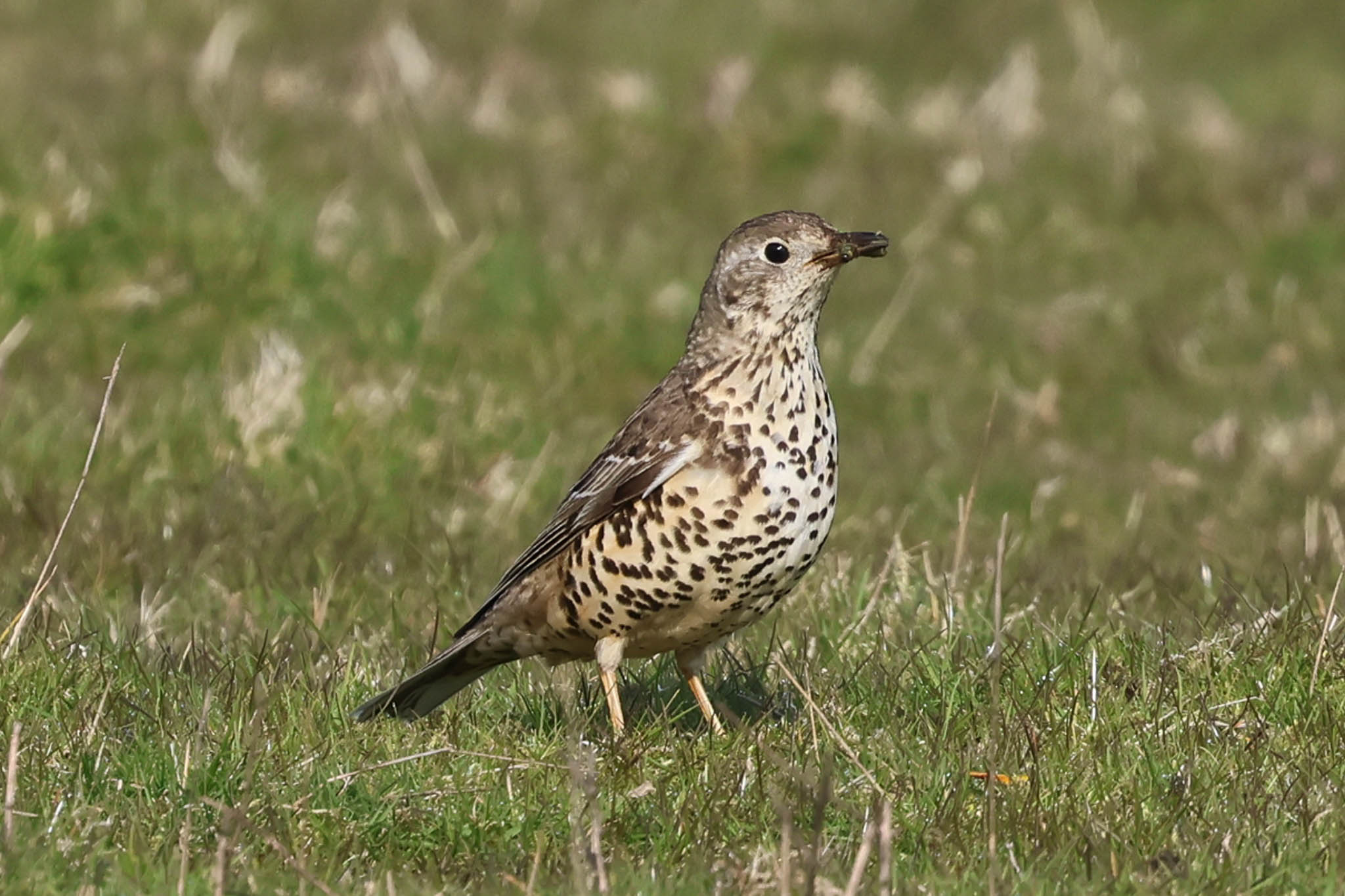
A Spoonbill flew over the road and we watched it head off across the grazing marshes towards Decoy Wood. Three geese flew over our heads, with a mixture of low honking and higher pitched yelping calls – two Pink-footed Geese and a Greylag. As they headed off away from us, we could really see the size difference, the Pink-footed Geese noticeably smaller.
We had a look to see if we could find the Grey Partridges out on the grazing marsh the other side, but there was no sign of them now. We checked back on the west side, back along the hedge where it was more sheltered – there was no sign of the partridges there either, but we did find a Whimbrel now out on the grass, which then flew off east. A Red Kite drifted over the marshes behind the Lookout.
As we walked through the pines out towards the beach, there were a few tits in the bushes. A pair of Long-tailed Tits were hiding in the brambles at the top of the boardwalk. A couple of Meadow Pipits were displaying out on the edge of the dunes, flying up and parachuting down to land on the fence. There were four Brent Geese feeding out by the Gap and several Shelducks on the saltmarsh as we made our way east, along with a couple of Oystercatchers.
Thankfully, there was a bit of shelter from the pines this morning, as we got down to the cordon. A Skylark fluttered up singing. The wind had carried a lot of sand off the beach onto the far end. Scanning across, we quickly located the Shorelarks down on the edge of the sand so, after a quick look through the scope from here just in case, we then walked down for a closer look.
We had a great view of the Shorelarks now as they fed in the shorter vegetation, we could see their yellow faces and black masks. Even better, they gradually worked their way towards where we were standing on the path, eventually coming much closer. There are only four Shorelarks left now (there had been a maximum of 14 over the winter), but they often leave before the end of March to start making their way back to Scandinavia for the breeding season, so these four are already here later than we would normally expect to see them. Very nice that they stayed for us!
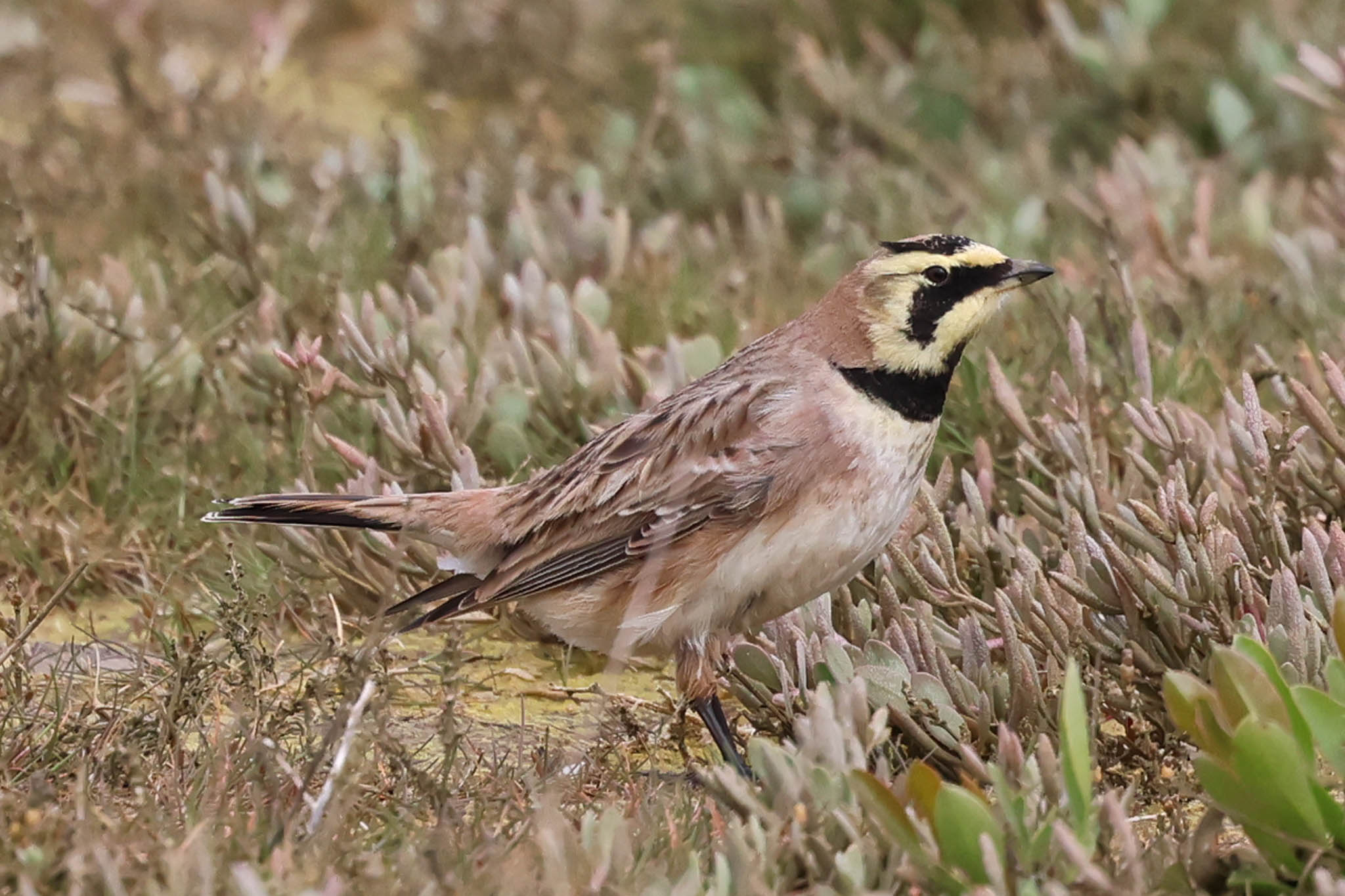
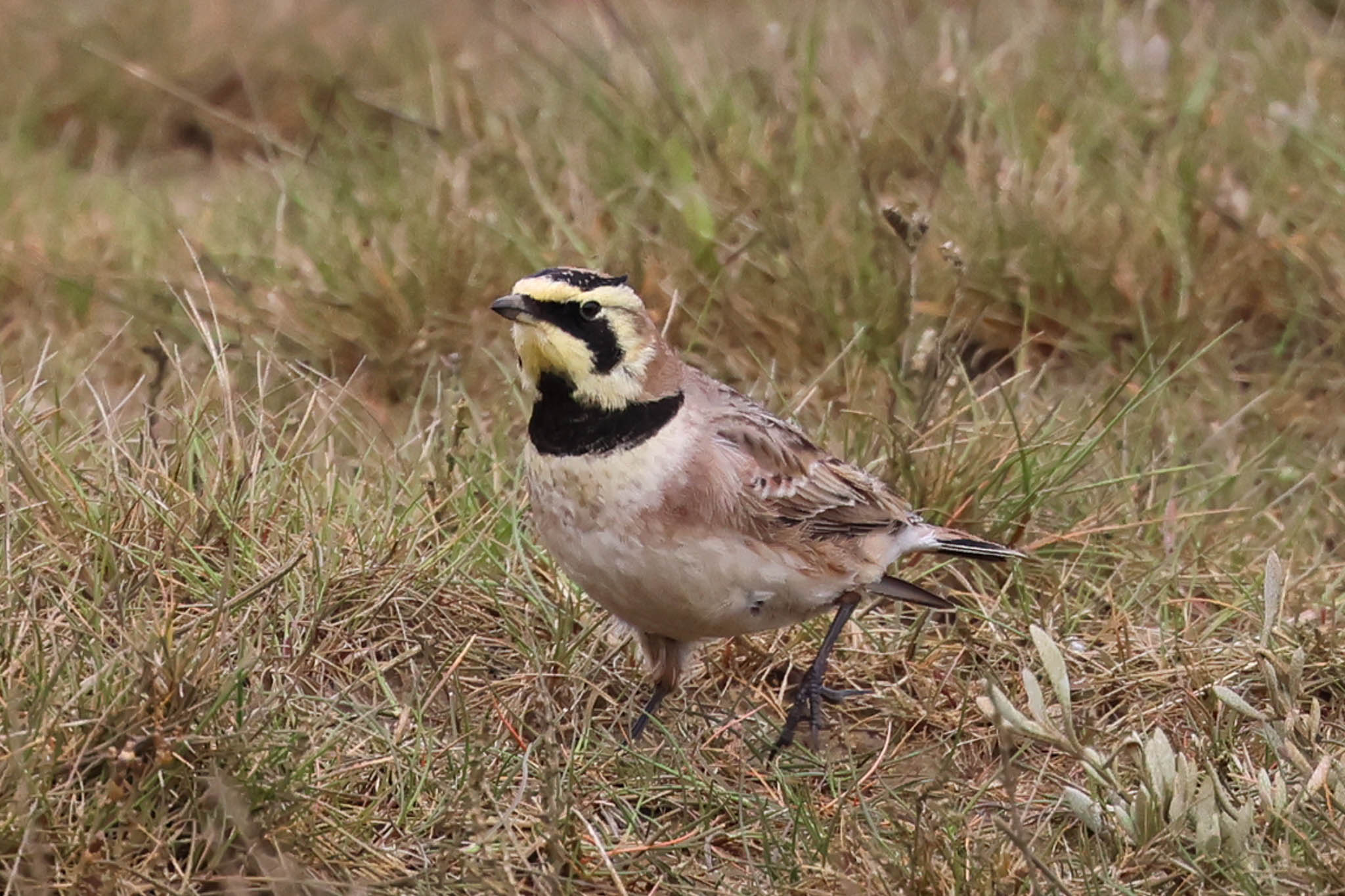
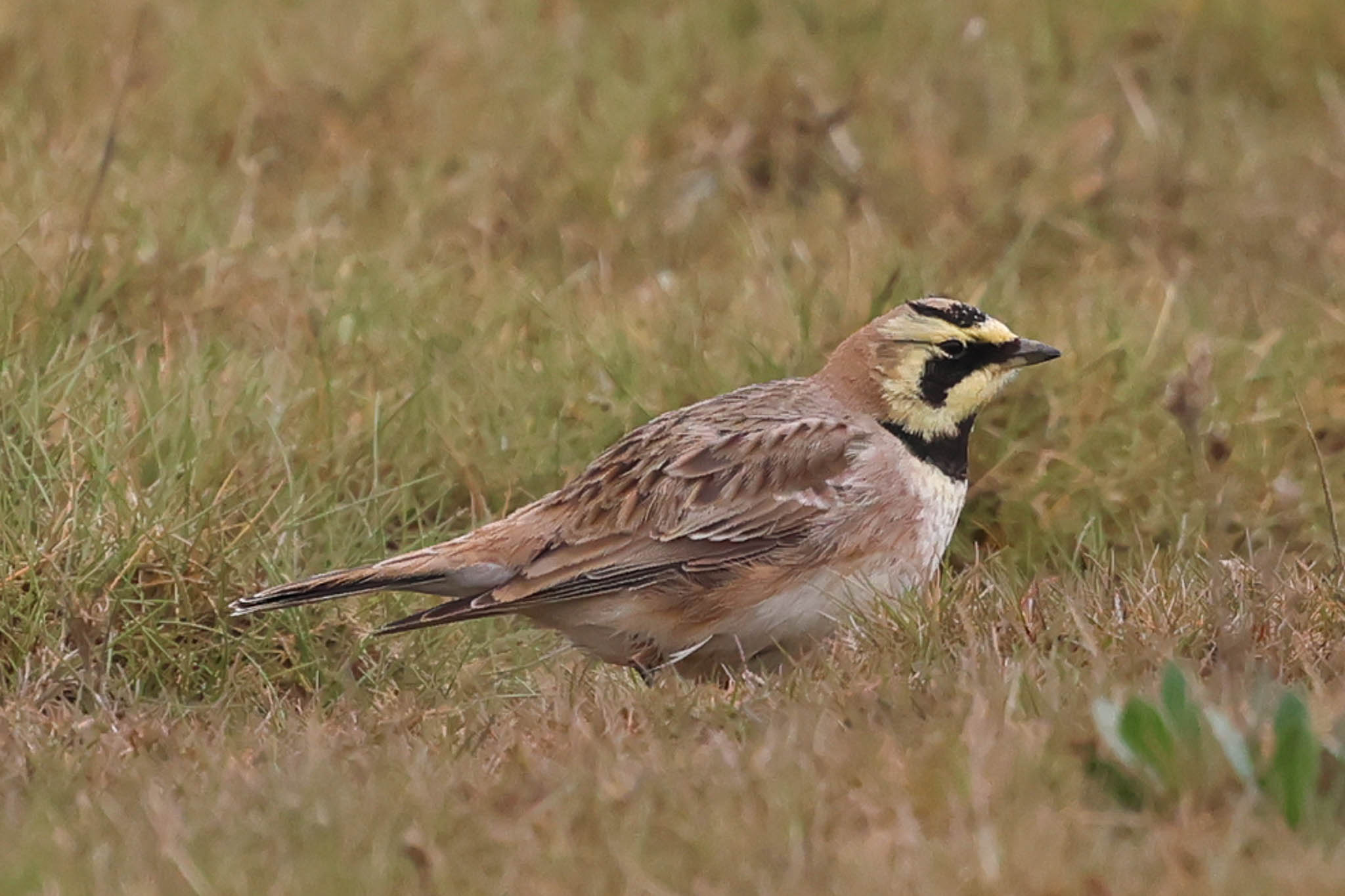
It looked very windy out on the beach and unpleasant with all the sand blowing across, so we decided to walk back. While we stopped to use the facilities, we had a quick scan of the grazing marshes. A Common Snipe was feeding in the bottom of one of the shallow water channels. A couple of Brown Hares were sunning themselves further back, where a family of Egyptian Geese with some already well grown goslings were feeding on the grass. We heard a Grey Partridge call, but we still couldn’t find it – it sounded like the call came from the long grass on the bank somewhere. A Swallow was flying around the building.
We made our way west along the path on the southern edge of the pines now, where we figured we should be able to find some shelter from the wind. A Blackcap and a couple of Chiffchaffs were singing in the trees and just beyond, we stopped to watch a pair of Treecreepers feeding on the trunks of the poplars. We could hear a Willow Warbler singing now, and a little further on we found it perched higher in one of the trees and got it in the scope. There were a few Coal Tits in the pines and a couple of Long-tailed Tits flitted ahead of us. There were a few butterflies out here enjoying the sunshine now – several Speckled Woods and a Holly Blue flew round beside us.

Continuing on, we stopped first for a quick look at Salts Hole, where a couple of Tufted Ducks were diving out in the middle, then again to scan from the gate before Washington Hide. There were several Meadow Pipits and a Linnet down in the grass and Marsh Harriers out over the marshes beyond. We could see some hirundines over the reeds which when they dropped down we could see were two House Martins, our first of the year. Two waders flew past, another Whimbrel together followed by a Bar-tailed Godwit.
There were more butterflies around the flowers by Meals House, a couple of Orange Tips and a Green-veined White, and a Brimstone flew past. A Green Tiger Beetle was on the bare ground just beyond. A Redpoll flew over calling, but we couldn’t see it over the pines. Then on to the crosstracks, where we turned down towards Joe Jordan Hide. The hide has been closed as it was unsafe, so we stood below and scanned the marshes over the wall. A Spoonbill was collecting nest material on the edge of the pool out in the middle and a Great White Egret came up from the reeds the other side of the old fort, flew round and then dropped down behind the hedge.
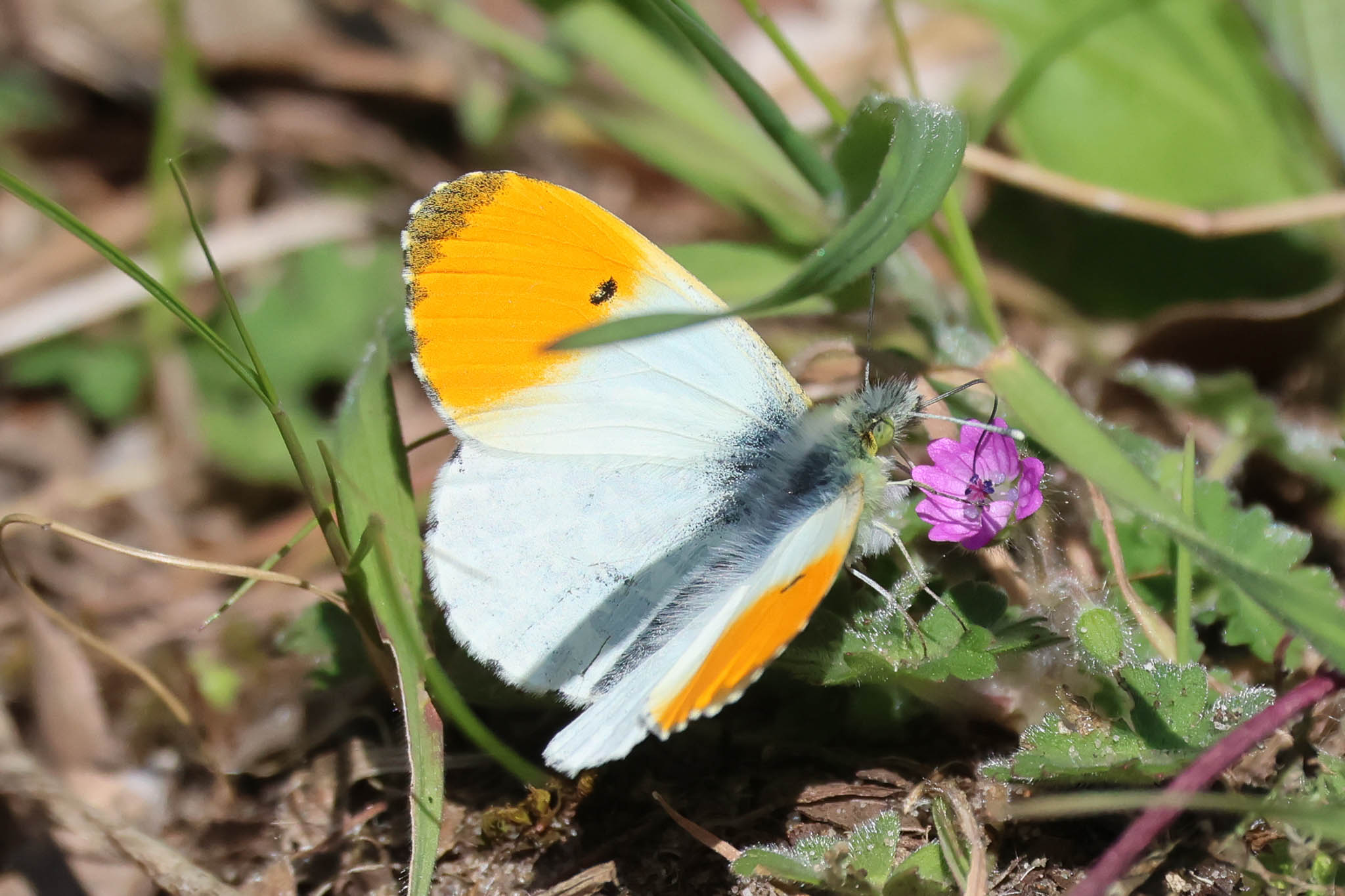
It was a nice place to relax in the sunshine today and have a quick rest, before we set off back. But a new hide here would be nice! On the walk back, a Sparrowhawk shot across the path just beyond Meals House and up into the pines. As we got to Salts Hole, we could hear a Green Sandpiper calling and as we stopped to look, it flew up from the reeds and disappeared off west. A Siskin flew over calling too.
Back at Lady Anne’s Drive, we collected our lunches from the minibus and dropped off the scope. We commented that, if we didn’t take it with us we would stand a much better chance of seeing the Grey Partridges and sure enough, as we walked back to the Lookout the Grey Partridges were back out on the grazing marsh. Thankfully they were close enough that we didn’t really need the scope!
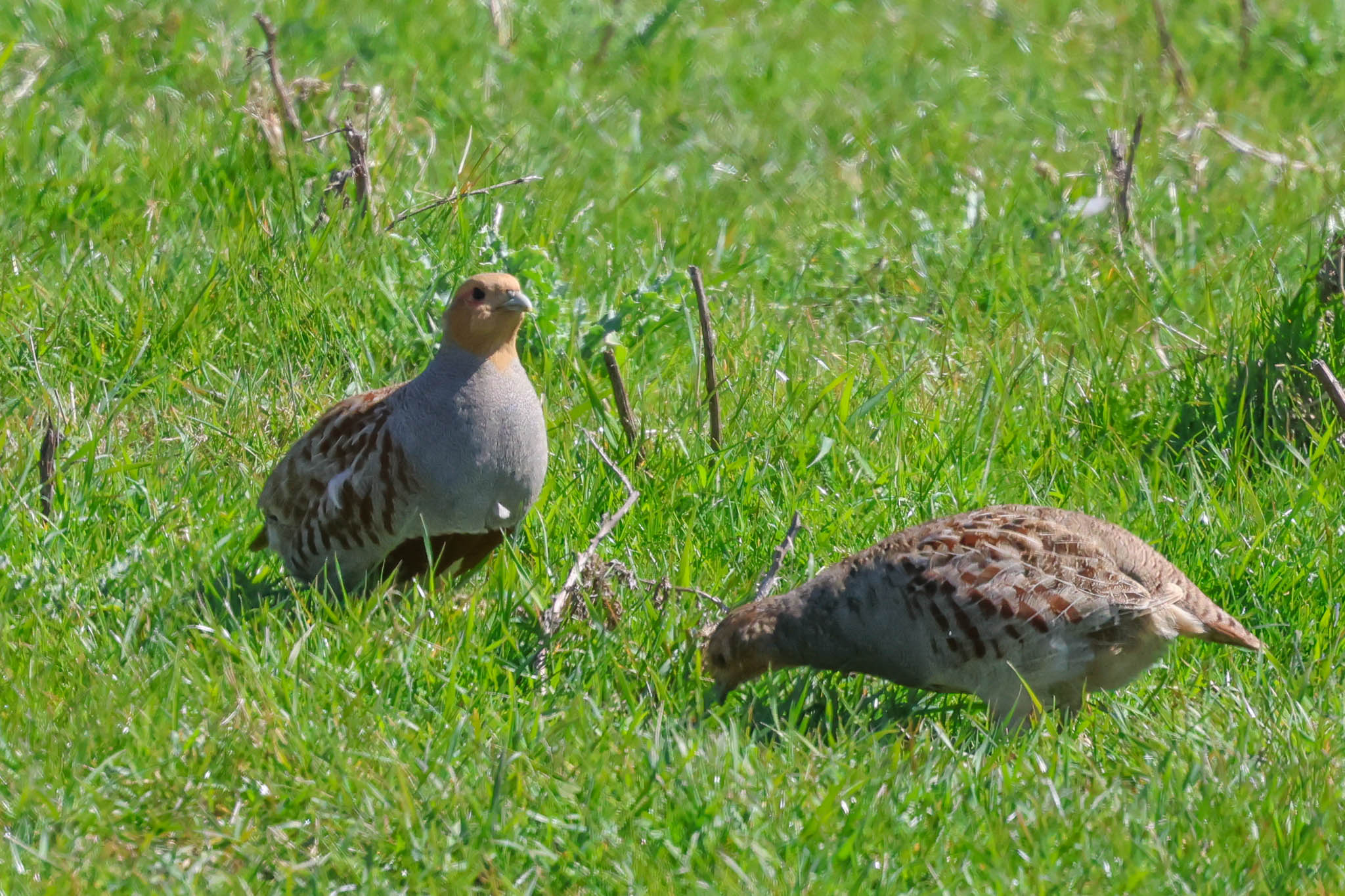
After lunch, we drove over to Titchwell, thinking we might be able to get some shelter from the wind in the hides and see if anything had dropped in. A Song Thrush was singing in the car park when we arrived and as we walked along the path towards the Visitor Centre we could hear Blackcaps alarm calling and stopped to watch first a brown headed female and then a black capped male in the sallows.
There was nothing around the feeders today apart from a couple of Woodpigeons, so we continued on to the main path and out onto the reserve. There were lots of hirundines over the reedbed including several more House Martins, and a few Sand Martins and Swallows. We stopped to watch and could see the square white rumps of the House Martins as they swept low over the bank. A Great White Egret came up out of the reebed and flew round in front of us, before dropping down again behind the reeds.
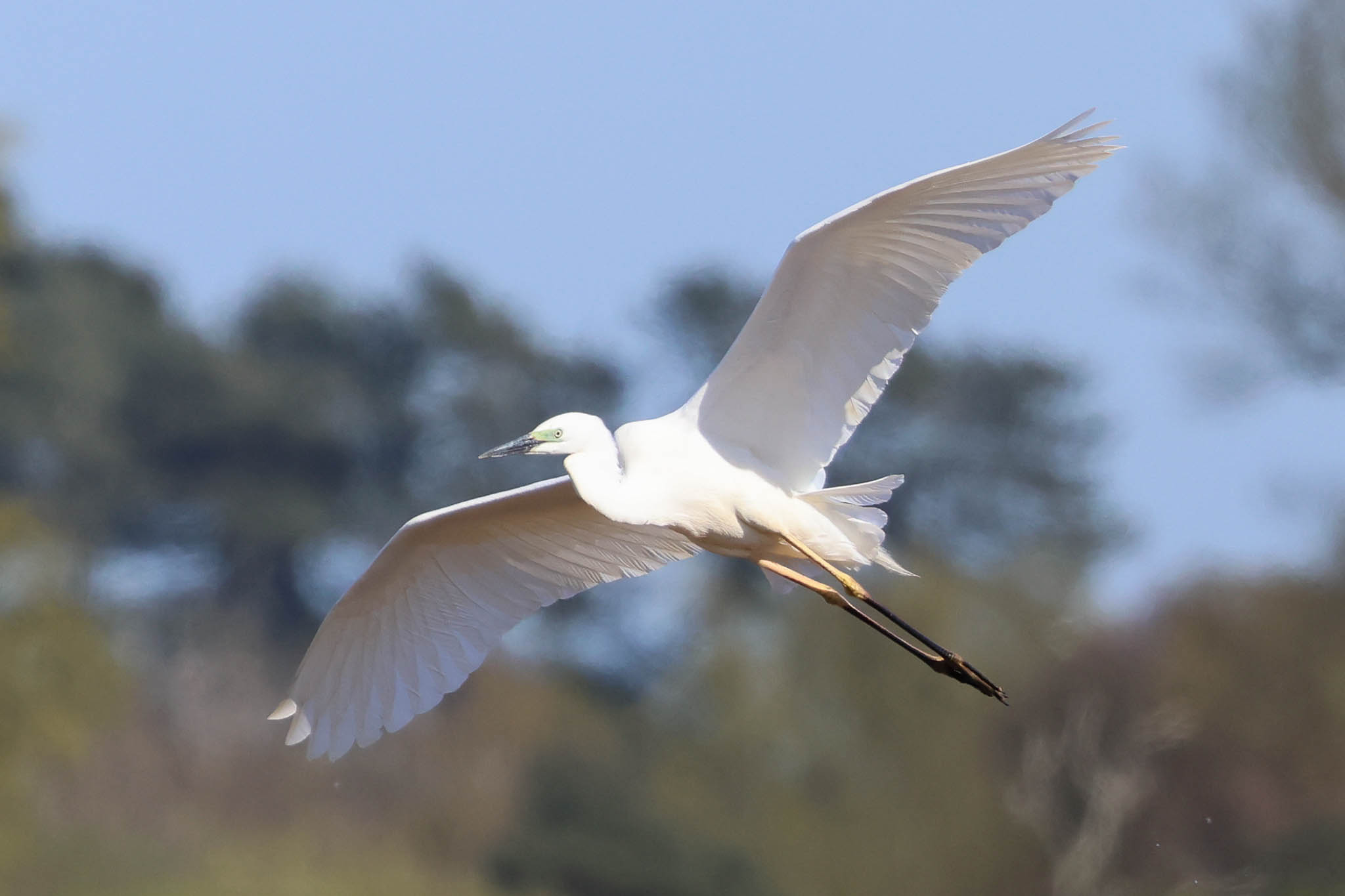
A Reed Warbler was singing from the reeds, but keeping well down out of the wind. A Marsh Harrier hung in the air over the back of the reedbed. We could see a couple of Common Pochard on the reedbed pool but they disappeared behind the reeds at the front and we found them again from a little further up, sheltering in the channel.
We could see some Avocets feeding right in front of Island Hide, so we decided to brave it. The worst of both worlds, the hide was facing into the into wind today and inside we were out of the warmth of the sun too. There was a very good view of the Avocets from here, although they were struggling in the deep water which was being whipped up by the wind.
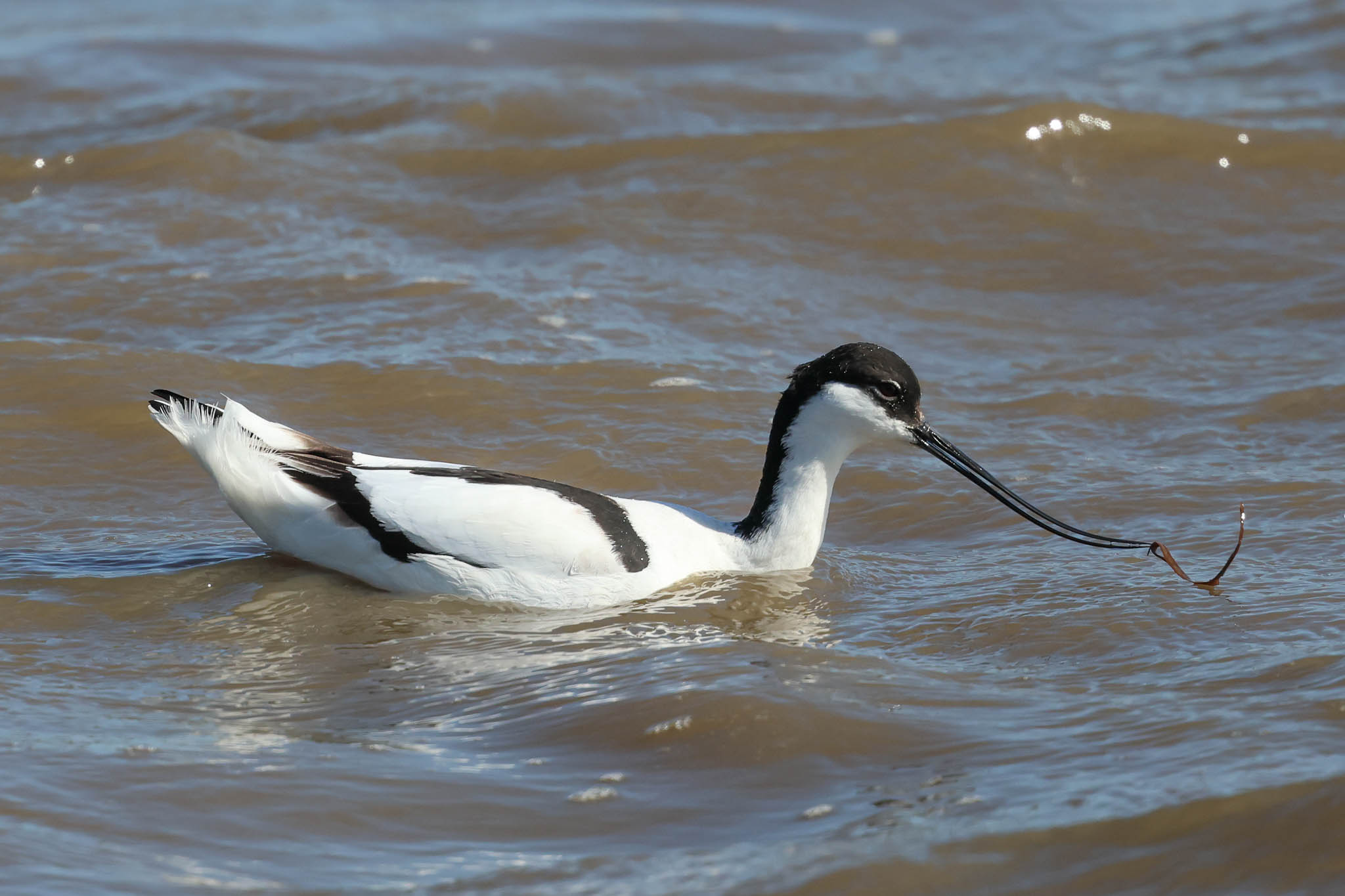
There were a couple of Ruff on the closest island too, feeding between the Black-headed Gulls, and we had a nice view of them in the scope, already starting to moult into breeding plumage and very different colours from each other! Several Turnstones had presumably come in off the beach to seek shelter on the Freshmarsh and were picking around the edges of the other islands and there were one or two Dunlin with them too.
After a good look round from here, we headed back out into the sunshine and round to the south side of Parrinder Hide where we would be out of the wind. A few Teal were feeding in the water just below the bank, the drakes looking stunning in the sunshine in their smart breeding plumage. A small group of Brent Geese flew in from the saltmarsh and dropped down onto the water.

From Parrinder Hide, there were more waders.A line of Black-tailed Godwits, several in bright rusty breeding plumage, were roosting on one of the islands too and there were several Ringed Plovers around the edges. A couple of Little Ringed Plovers were on the mud in front of the other side of the hide, and through the scope we could see their golden yellow eye rings. Behind them were four Dunlin, two already moulting into breeding plumage and starting to get their black belly patches.
There were good numbers of Mediterranean Gulls with the Black-headed Gulls on the islands on the far compartment and two Sandwich Terns appeared too. They flew off before we could all get a look at them, but when they came back again there were four, and the next time they did it there were six Sandwich Terns – we could now see their shaggy crests and yellow-tipped black bills.

We decided to brave the wind and head out towards the beach – and thankfully, when we got outside, it seemed like it might have dropped a little. A Curlew was feeding in the vegetation close to the bank on the Volunteer Marsh and there were a couple more Curlew and several Oystercatchers in the channel on the far side. More Oystercatchers were roosting on the Tidal Pools and we found a lone Grey Plover with them, although it was at the back and asleep so not the best of views.
The tide was coming in out on the beach, pushed in by the wind too, and the water was already well up onto the sand. There were several silvery-grey Sanderling running in and out of the breaking waves. There didn’t seem to be anything moving offshore, so having paid homage to the sea, we turned and headed back to get out of the wind.
There were still a couple of notable moments on the walk back. When we got back to the Freshmarsh, we could see a group of godwits on the compartment closest to the path and a quick look confirmed they were 15 Bar-tailed Godwits, including several males in bright rusty breeding plumage.
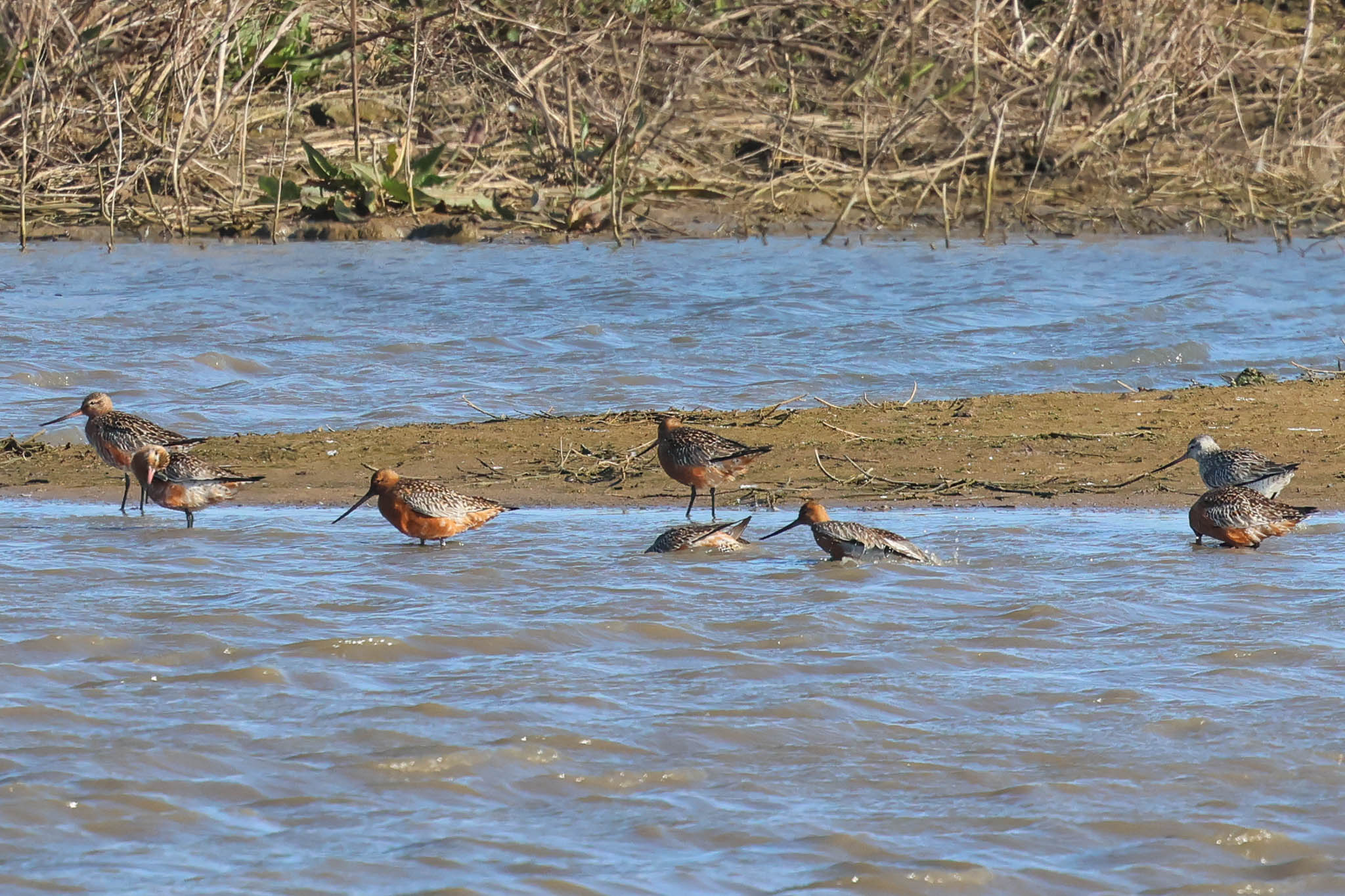
On their way north, significant numbers of Bar-tailed Godwits had been displaced inland by the wind over the last couple of days, turning up in several land-locked counties. Several flocks were seen elsewhere in Norfolk too and these had obviously just dropped in and were busy preening and bathing. After packing up the scope, we looked back and they had flown off already. As we got back to the reedbed, a Whimbrel flew high east, another wader on the move, real migration in action today.
Unfortunately, we were out of time, so it was straight back to the car park and time to head for home. It had been a fun few days, and despite the chilly wind we had seen a great variety of birds.
















